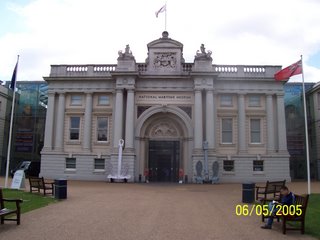
Die National Maritime Museum is by Greenwich en mag gratis besoek word. Ek het so bietjie meer daarvan vertel toe ek oor Greenwich geskryf het.
Die coolste ding in die museum? 'n Masjien waarmee jy golwe kan maak! Ek verstaan uiteindelik ook hoe dit werk ;-)
Hier is meer detail:
History of the National Maritime Museum
The National Maritime Museum (NMM) was formally established by Act of Parliament in 1934 and opened to the public by King George VI on 27 April 1937. It includes the 17th-century Queen's House and, from the 1950s, the Royal Observatory, Greenwich.
There is also a small museum at Cotehele Quay on the Tamar, Cornwall, with the NMM/National Trust sailing barge Shamrock, and the 'Valhalla' ships' figurehead collection on Tresco, Isles of Scilly.
The collections comprise about 2.48 million items, many on loan to museums elsewhere in Britain. The public galleries at Greenwich display a thematically arranged selection and the remainder are accessible for public interest and research in various ways. The majority of the NMM's small-boat collection is on display at the new National Maritime Museum, Cornwall, at Falmouth.
Find out more about the Museum's collections.
The Museum is funded by Government with additional income derived from trading activity and sponsorship. Entry to all Museum sites at Greenwich is free but charges are made for some special exhibitions. The Museum's objectives and targets are outlined in its current Funding Agreement.
Greenwich began to develop as a cultural visitor destination with Sir James Thornhill's completion of the Painted Hall (1707–26) in what is now the Old Royal Naval College (founded in 1694 as the Royal Hospital for Seamen). From 1823 a 'National Gallery of Naval Art', eventually including 300 portraits, paintings and artefacts, was created in the Hall, the first of its kind. A separate Naval Museum was also established in the Hospital buildings when it became the Royal Naval College - the 'Navy's university', 1873–1998.
After its foundation in 1910, the Society for Nautical Research (SNR) independently developed the aim of founding a 'national naval and nautical museum'. In 1927–28, following a public appeal organised by the Society, one of its wealthy members Sir James Caird (1864–1954) purchased the A.G.H. Macpherson Collection of maritime prints - over 11,000 items - with this in view. He also purchased the ship models from the training ship Mercury, with many other items being bought by him or otherwise donated.
All were vested in a temporary Trustee board, 1927–34, replaced by permanent NMM Trustees on passing of the 1934 Act. The contents of the Naval Museum in the College and other official material were also transferred to the care of the NMM Trustees under the 1934 Act, the Greenwich Hospital Collection from the Painted Hall being added by separate agreement in 1936.
The Museum's first Director from 1934 to his death was Professor (Sir) Geoffrey Callender (1875–1946), formerly Professor of History at the Royal Naval College, who was also both Secretary and Treasurer of the SNR and the main intellectual and organizational force behind the Museum's creation.
In 1933 the Royal Hospital School at Greenwich moved to Suffolk, vacating the Queen's House and related buildings which it had occupied since 1806, originally as the separate Royal Naval Asylum but combining with the 18th-century Greenwich Hospital School from 1821. The House was restored by the Ministry of Works and the flanking wings - added for the School between 1807–76, began a long period of museum conversion, largely at Sir James Caird's expense: this was only completed in 1951.
All the Museum buildings have subsequently been upgraded at various times and a full modern redevelopment of the main galleries, centring on what is now the Neptune Court, was completed 1999.
The Museum has the most important holdings in the world on the history of Britain at sea, including maritime art (both British and 17th-century Dutch), cartography, manuscripts including official public records, ship models and plans, scientific and navigational instruments, time-keeping and astronomy (based at the Observatory), and in many other categories.
You can see many items from the Museum's holdings on the Collections Online website. The Maritime Art Greenwich website is a searchable database of selected paintings plus in-depth content on some of the major themes of maritime art.
Its British portraits collection is only exceeded in size by the National Portrait Gallery and its holdings related to Nelson and Cook, among many other individuals, are unrivalled. It has the world's largest maritime historical reference library (100,000 volumes) including books dating back to the 15th century.
The Museum is also unique in the architectural importance of its main buildings, the Queen's House in particular being the keystone of the historic park-and-palace landscape of 'Maritime Greenwich’, which was inscribed as a UNESCO World Heritage Site in 1997.
Flamsteed House (1675–76), the original part of the Observatory, was designed by Sir Christopher Wren and was the first purpose-built scientific research facility in Britain. Take a virtual tour of Flamsteed House.
© NMM London
No comments:
Post a Comment